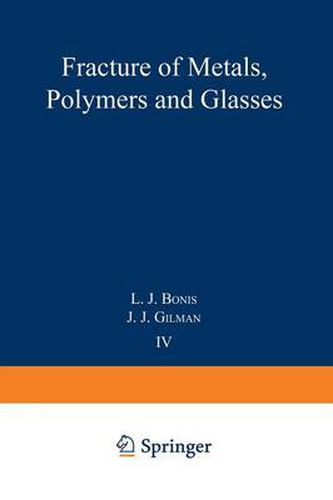Readings Newsletter
Become a Readings Member to make your shopping experience even easier.
Sign in or sign up for free!
You’re not far away from qualifying for FREE standard shipping within Australia
You’ve qualified for FREE standard shipping within Australia
The cart is loading…






This title is printed to order. This book may have been self-published. If so, we cannot guarantee the quality of the content. In the main most books will have gone through the editing process however some may not. We therefore suggest that you be aware of this before ordering this book. If in doubt check either the author or publisher’s details as we are unable to accept any returns unless they are faulty. Please contact us if you have any questions.
Elucidation of the various mechanisms responsible for fracture in different materials was the general subject of the Fourth Annual Symposium on Fundamental Phenomena in the Materials Sciences held January 31 and February 1, 1966, in Boston and sponsored by the Ilikon Corporation of Natick, Massachusetts. In an analysis of the brittle-to-ductile transition in polycrystalline metals, T. L. Johnston (Ford Motor Company) placed major emphasis on factors related to the plastic resistance associated with grain boundaries and the effects of plastic anisotropy. Utilizing a generalized form of the Griffith criterion, he said it can be readily shown that several individual factors may be made reasonably quantitative and that the nature of plastic response can be predicted. Specifically, it can be shown that a critical factor relates to the length of a plastic shear zone which is constrained by an elastically loaded matrix. As this length increases, the Griffith inequality is satisfied and brittle failure occurs; however, the use of decreased grain sizes or the refine ment of dislocation or twin distribution can further tend to homoge nize the plastic flow and to decrease the magnitude of the shear zone. Of considerable importance in the consideration of plastic resistance is the availability of favorably oriented slip systems in aa un sheared crystallite.
$9.00 standard shipping within Australia
FREE standard shipping within Australia for orders over $100.00
Express & International shipping calculated at checkout
This title is printed to order. This book may have been self-published. If so, we cannot guarantee the quality of the content. In the main most books will have gone through the editing process however some may not. We therefore suggest that you be aware of this before ordering this book. If in doubt check either the author or publisher’s details as we are unable to accept any returns unless they are faulty. Please contact us if you have any questions.
Elucidation of the various mechanisms responsible for fracture in different materials was the general subject of the Fourth Annual Symposium on Fundamental Phenomena in the Materials Sciences held January 31 and February 1, 1966, in Boston and sponsored by the Ilikon Corporation of Natick, Massachusetts. In an analysis of the brittle-to-ductile transition in polycrystalline metals, T. L. Johnston (Ford Motor Company) placed major emphasis on factors related to the plastic resistance associated with grain boundaries and the effects of plastic anisotropy. Utilizing a generalized form of the Griffith criterion, he said it can be readily shown that several individual factors may be made reasonably quantitative and that the nature of plastic response can be predicted. Specifically, it can be shown that a critical factor relates to the length of a plastic shear zone which is constrained by an elastically loaded matrix. As this length increases, the Griffith inequality is satisfied and brittle failure occurs; however, the use of decreased grain sizes or the refine ment of dislocation or twin distribution can further tend to homoge nize the plastic flow and to decrease the magnitude of the shear zone. Of considerable importance in the consideration of plastic resistance is the availability of favorably oriented slip systems in aa un sheared crystallite.